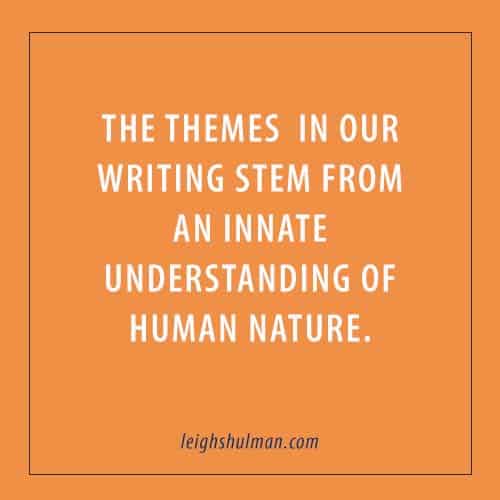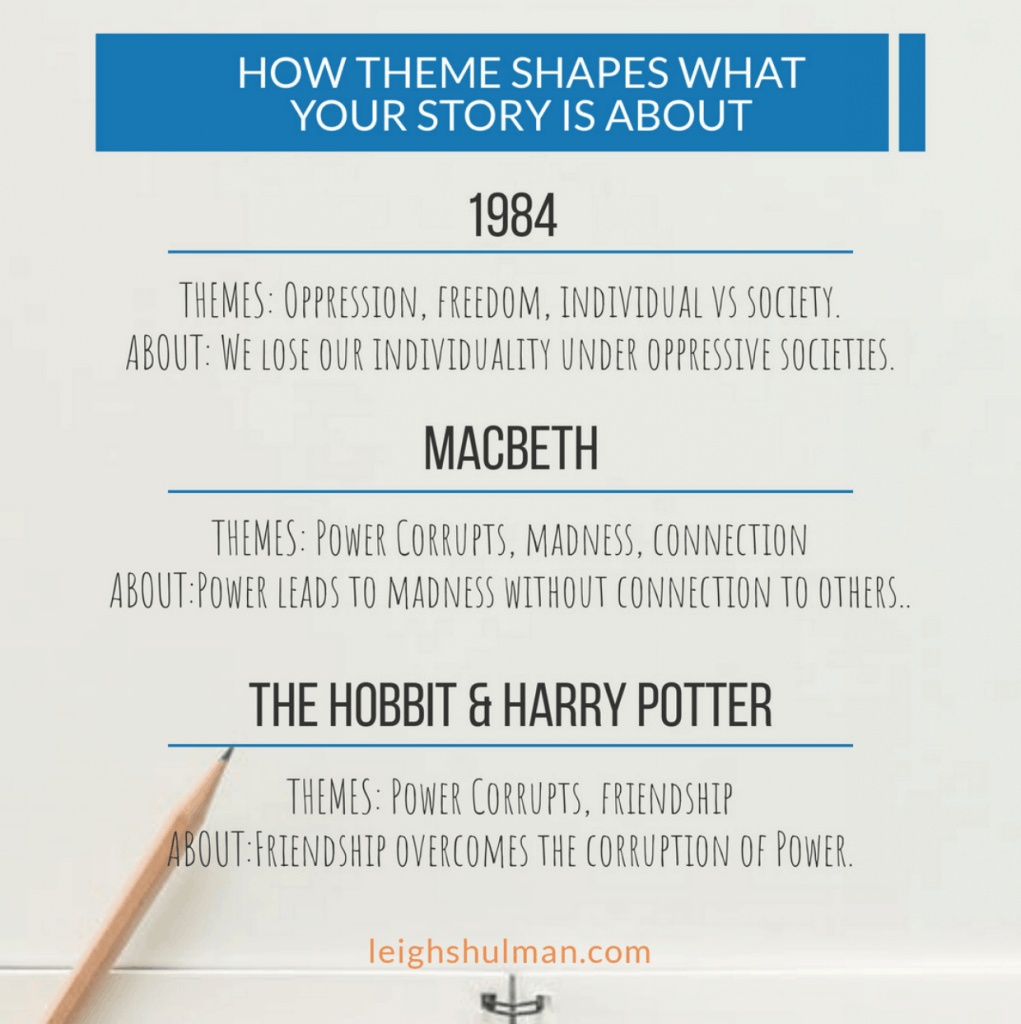It’s been said that every literary work can be boiled down to only ten themes. And so we see over time and across cultures, our written work connects and reconnects with certain images, ideas and emotions. This is what we call theme, and these themes appear in short stories, poems, books and pretty much all other writing, creating powerful and enduring written traditions.
Even when we don’t intend to weave them into our work, they’re there. We can’t help ourselves, because themes stem from an innate understanding of human nature. It’s how we share our experiences with others—through stories.
Themes allow layers of complexity to form around your characters. They elevate your story to one that goes beyond action and connects to the nature of what it is to be human, creating a story that reaches back in time to those who came before while simultaneously paving a path forward.
That’s a lot for one little literary device to do, and luckily, we write theme into our work naturally. When we write, theme spills from our pens and onto the page even when we don’t intend it, creating complicated and truthful visions of the human experience. We understand them as easily as breathing because they have been part of our lives since before we were born.
Here are some ways you can be more aware of the themes in your work and highlight them so they support the about of your story, bringing a clear message to your reader that weaves your characters, setting and narrative together into one human truth.

Literary devices and terms to understand
Before we dive into ways your theme carries the meaning of your writing, let’s discuss the various literary devices that allow your themes to layer and build your overall message.
We’ll start at the simplest level and work our way up to the big picture.
Symbol
A symbol is a specific and finite image that stands in for a more abstract idea. A dead tree symbolizes death. A rose symbolizes love. A dove is peace. Wild hair can stand for freedom or lack of control.
Symbols have historical literary meaning in the sense they’re traditional and have been used in similar ways over long periods of time and in many forms of writing. You can control how your audience sees the symbolism in your writing by the context you create for them. (More on that soon.)
Symbolism can appear as physical objects, as people and as events. Take the following three symbols. A battle scene, a dying tree and a sick old man lying on the side of the road. All three represent death.
Motif
Motifs are recurring symbols in a piece of writing that when taken together create an overall impression. Over the course of a piece of writing, motif develops into a theme.
Let’s say you have one story with a dove, sitting in a cherry tree full of new blossoms on a sunny spring morning. These are all signs of life and taken together, the story gives the recurring feeling of new beginnings, growth and possibility. When your story takes place in this setting, you create a lens through which your readers see your characters and the story as a whole.
While the events of your story can match the symbols and motifs of the setting, they don’t always have to. Imagine a murder taking place on such a beautiful spring morning. It subverts the message making your readers question the overall meaning.
Theme
The theme takes your symbols and motifs and weaves them together into an overarching message that persists throughout your work. This is the meaning of your work.
Themes allow layers of complexity to form around your characters. Click To TweetSome examples of themes: Death. Love. Sisterhood. Community. Good vs evil. You can also find an extensive list of common themes here.
Your symbols and motifs infuse your theme with a particular message. If your theme of Love takes place on a beautiful sunny summer day where children play and everything turns out peacefully and well, that creates one way of seeing love. If your love story takes place on a sunny day that suddenly turns dark and treacherous, that creates another way of seeing love.
Your themes connect to form a strong and clear message for your story. This is the About.
The About of your story
About is a term I use specifically to describe what you want your readers to understand and feel when they’re finished reading your book.
The various themes, motifs and symbols in the writing work together to present this overall meaning. While the same About can apply to many different books and stories, the imagery, scenes and characters you describe in your writing creates a very personal and specific message for your story.
Examples of Abouts:
The bond of sisterhood overcomes cultural differences and even hatred.
People are lonely and looking for human connection.
A person’s a person no matter how small.
Love always leads to sadness.
Going back to the love story that takes place on a sunny day that suddenly turns black. What can this tell us about love? Depending on how you present your imagery, it could mean different things.
You could write a story leaving people with the understanding that love has many ups and downs. It’s not just all spring and flowers.
Your story can warn people not to trust love. Even when all seems beautiful, it can turn dark at any moment.
Or maybe you’re telling people that love is hard and you will have to face many difficult things if you want to experience true love.
The scenes you choose, the characters you create and the structure and arc of your story bring these images together to present a greater message.
Luckily, this happens naturally.
Themes appear in our drafts even when we don’t intend to include them. It happens naturally with the language we choose, the images we include and the way we talk about characters, both physically and metaphorically.
Once you’ve written a draft, you need only go back to read and become more aware of what you’ve already written

Create a deeper awareness of your themes with these four steps:
1. First, make sure you know the About of your story.
How would you describe IN ONE SENTENCE OR SHORT PHRASE what you want your readers to understand and feel from your writing? One sentence helps you maintain clarity and keeps you from going on tangents or getting lost in explanations.
Explore your About more deeply by checking out these posts here and here.
2. Read through your draft, taking note of each symbol, motif and theme.
As you read, keep a running list of the themes you see popping up in your work. When you run across symbols and motifs, connect them to the theme they reinforce. Sometimes, your symbols and motifs will support more than one theme. This is a good sign. You don’t have to make any decisions about them quite yet. Just keep track of them.
Once you have a whole list of the themes with the symbols and motifs supporting that theme, you can begin to think about the ways your imagery supports or distracts from the theme.
3. Ask yourself the following questions about the ways your themes work together in context with your story elements:
Do your themes contradict? Does the contradiction work or does it confuse your overall message, that is your About. What would you have to change to make it clearer?
Are there themes that appear that seem to keep appearing but you didn’t intend them to be there. What do they suggest to you? How do they shape the way you see the characters and the story? Follow the threads that suggest themselves to see if they add depth to your story.
Are there too many themes? Too many themes can make a muddle of your writing because your readers won’t know which threads to follow and which to ignore. They create confusion because they lead us in too many directions which makes it harder to understand a clear message.
Which themes are central to the About of your book and which can be minimized or removed altogether?
4. Once you’ve answered the questions, decide what to keep, what to edit, what to add and what to remove in order to streamline your themes so they tell the story you want them to tell.
Examples of themes and how they work together to form your About:
In both Harry Potter and The Hobbit, you’ll find themes of friendship, as well as how power corrupts. The themes combine to tell a story About the ways friendship overcomes corruption. Very different stories, characters and details, but the underlying About is the same.
Shakespeare’s play Hamlet, we see themes of madness, as well as power corrupts. Hamlet is an example of what happens when you approach corruption and deception through madness. In Harry Potter and Hamlet, the characters turn to each other for help as they face corrupt power, but Hamlet pretends to be mad, separating himself from the other characters and deepening the madness and corruption of others. The About of Hamlet? Corruption leads to madness without the connections of love and friendship.
George Orwell’s 1984 includes the themes of corrupt power, oppression, freedom and the individual vs society. It tells a story about how individual freedoms are lost under corrupt societies that seek to oppress and control.
Pro-tip 1: Balancing major and minor themes
You will have both major themes and minor ones. Your About addresses the major ones. The minor ones will connect appear throughout, teaching lessons that connect to your larger about, but they also help you develop your subplots and characters.
Love, for example, is a theme in 1984, too. It is minor in comparison to the larger theme of oppression, but it helps us connect to the two main characters and root for them. When they lose their love because of an oppressive government, we feel the loss as well. Were you to remove the subplot of the relationship between two of the characters, the main themes would still exist.
Pro-tip 2: Get an outside opinion
Every writer needs a reader. Sometimes, your writing says things you didn’t intend. You can turn to a beta reader to give you additional insight. Even the most experienced writer can be too close to her work to see clearly. In which case, take a break and hand your writing to a reader you trust. Ask for them to highlight the themes of your work and then find out how they understood the themes.
This kind of deep work on your writing can feel overwhelming. That’s normal, especially if this is a new way of looking at your work. Even if it’s not new, this kind of analysis pushes you to see your work in new and layered ways, which is often uncomfortable. It’s worth the effort, though, as you develop your craft, challenge your writing skills and offer more meaning for your readers.

